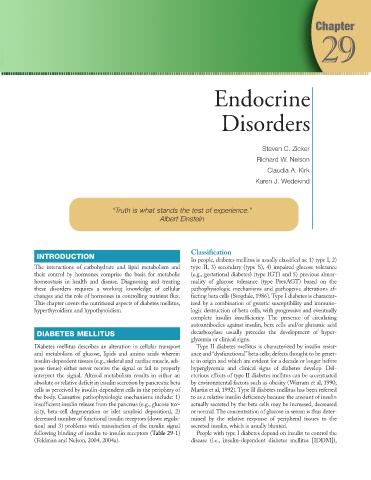Page 540 - Small Animal Clinical Nutrition 5th Edition
P. 540
Chapter
29
VetBooks.ir
Endocrine
Disorders
Steven C. Zicker
Richard W. Nelson
Claudia A. Kirk
Karen J. Wedekind
“Truth is what stands the test of experience.”
Albert Einstein
Classification
INTRODUCTION
In people, diabetes mellitus is usually classified as: 1) type I, 2)
The interactions of carbohydrate and lipid metabolism and type II, 3) secondary (type S), 4) impaired glucose tolerance
their control by hormones comprise the basis for metabolic (e.g., gestational diabetes) (type IGT) and 5) previous abnor-
homeostasis in health and disease. Diagnosing and treating mality of glucose tolerance (type PrevAGT) based on the
these disorders requires a working knowledge of cellular pathophysiologic mechanisms and pathogenic alterations af-
changes and the role of hormones in controlling nutrient flux. fecting beta cells (Stogdale, 1986).Type I diabetes is character-
This chapter covers the nutritional aspects of diabetes mellitus, ized by a combination of genetic susceptibility and immuno-
hyperthyroidism and hypothyroidism. logic destruction of beta cells, with progressive and eventually
complete insulin insufficiency. The presence of circulating
autoantibodies against insulin, beta cells and/or glutamic acid
DIABETES MELLITUS decarboxylase usually precedes the development of hyper-
glycemia or clinical signs.
Diabetes mellitus describes an alteration in cellular transport Type II diabetes mellitus is characterized by insulin resist-
and metabolism of glucose, lipids and amino acids wherein ance and “dysfunctional” beta cells; defects thought to be genet-
insulin-dependent tissues (e.g., skeletal and cardiac muscle, adi- ic in origin and which are evident for a decade or longer before
pose tissue) either never receive the signal or fail to properly hyperglycemia and clinical signs of diabetes develop. Del-
interpret the signal. Altered metabolism results in either an eterious effects of type II diabetes mellitus can be accentuated
absolute or relative deficit in insulin secretion by pancreatic beta by environmental factors such as obesity (Warram et al, 1990;
cells as perceived by insulin-dependent cells in the periphery of Martin et al, 1992). Type II diabetes mellitus has been referred
the body. Causative pathophysiologic mechanisms include: 1) to as a relative insulin deficiency because the amount of insulin
insufficient insulin release from the pancreas (e.g., glucose tox- actually secreted by the beta cells may be increased, decreased
icity, beta-cell degeneration or islet amyloid deposition), 2) or normal.The concentration of glucose in serum is thus deter-
decreased number of functional insulin receptors (down regula- mined by the relative response of peripheral tissues to the
tion) and 3) problems with transduction of the insulin signal secreted insulin, which is usually blunted.
following binding of insulin to insulin receptors (Table 29-1) People with type I diabetes depend on insulin to control the
(Feldman and Nelson, 2004, 2004a). disease (i.e., insulin-dependent diabetes mellitus [IDDM]),

